
Flindersia ifflana, commonly known as hickory ash or Cairns hickory, is a species of tree in the family Rutaceae and is native to Papua New Guinea and Queensland. It has pinnate leaves with between four and twelve egg-shaped to elliptical leaflets, panicles of white or cream-coloured flowers and woody fruit studded with rough points.

Melicope elleryana, commonly known as pink flowered doughwood, pink evodia, corkwood, or saruwa, is a species of rainforest shrub or tree in the family Rutaceae, and is native to New Guinea, parts of eastern Indonesia, the Solomon Islands and northern Australia. It has trifoliate leaves and pink to white, bisexual flowers arranged in panicles in leaf axils.

Acradenia euodiiformis, commonly known as yellow satinheart or bonewood, is a species of tree that is endemic to eastern Australia. It has mostly trifoliate leaves, the leaflets narrow elliptic to lance-shaped, with prominent oil glands, and panicles of white flowers. It grows in and near rainforest.

Cryptocarya microneura is a rainforest tree growing at the eastern coastal parts of Australia.

Melicope micrococca, commonly known as hairy-leaved doughwood or white euodia, is a species of shrub or slender tree in the family Rutaceae and is endemic to eastern Australia. It has trifoliate leaves and white flowers borne in panicles in leaf axils.

Hibiscus splendens, the splendid hibiscus, is a species of flowering shrub or tree in the mallow family, Malvaceae. Other common names include hollyhock tree and pink cottonwood. H. splendens is a fairly common plant native to eastern Australia. The range of natural distribution is from Wollongong in the state of New South Wales to Blackdown Tableland National Park in central east Queensland. The habitat is on clearings or disturbances around the margins of the drier rainforests.
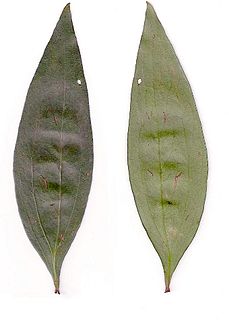
Stenocarpus salignus, known as the scrub beefwood is an Australian rainforest tree in the family Proteaceae. Found in warmer rainforests on the coast and ranges. It is often found in warm temperate rainforest on poorer sedimentary soils, or on volcanic soils above 750 metres above sea level. It was originally described by the botanist Robert Brown in 1810.
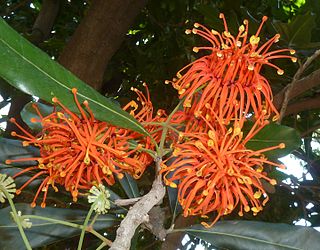
Stenocarpus sinuatus, known as the firewheel tree, is an Australian rainforest tree in the family Proteaceae. The range of natural distribution is in various rainforest types from the Nambucca River in New South Wales to the Atherton Tableland in tropical Queensland. Stenocarpus sinuatus is widely planted as an ornamental tree in other parts of Australia and in different parts of the world.

Rhodosphaera is a genus of plants in the family Anacardiaceae. The genus includes a single species, Rhodosphaera rhodanthema, which is a rainforest tree of eastern Australia. It grows in sub tropical rainforests and also in the drier form of rainforests. The natural range of distribution is from the Macleay River, New South Wales to Maryborough in south east Queensland. Common names include deep yellowwood, yellow cedar and tulip satinwood.

Polyscias murrayi, known as the pencil cedar, is a very common rainforest tree of eastern Australia.

Endiandra discolor is an Australian tree, growing from near Gosford, New South Wales to Tully, Queensland in the tropics. Common names include rose walnut and domatia tree.
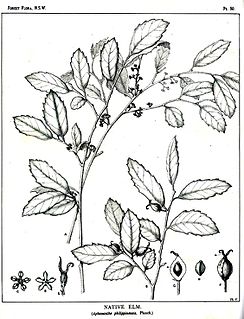
Aphananthe philippinensis is a common rainforest tree in the family Cannabaceae. In Australia it occurs from the Manning River in New South Wales to near Herberton in tropical Queensland. It was first described from the island of Luzon in the Philippines, hence the species name. The generic name of Aphananthe refers to insignificant flowers. This plant also occurs on the Solomon Islands and in Papua New Guinea

Pentaceras australe, commonly known as bastard crow's ash, penta ash or black teak, is the only species in the genus Pentaceras in the plant family Rutaceae. It is a small to medium-sized rainforest tree endemic to eastern Australia. It has pinnate leaves with up to fifteen leaflets, small white flowers arranged in panicles on the ends of branchlets, and winged seeds.
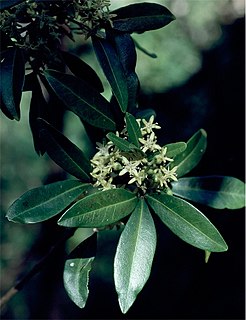
Acronychia suberosa , commonly known as corky acronychia, is a species of small to medium-sized rainforest tree that is endemic to eastern Australia. It has mostly trifoliate leaves with elliptic to egg-shaped leaflets with the narrower end towards the base, small groups of cream-coloured flowers and elliptical to spherical, creamy yellow to whitish fruit.
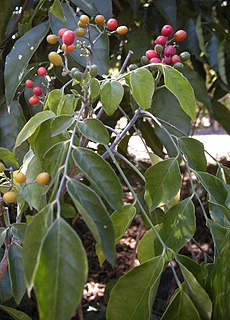
Micromelum minutum, commonly known as limeberry, dilminyin. kimiar margibur, tulibas tilos (Philippines), sesi (Indonesia) and samui (Thailand), is a species of small tree or shrub in the citrus plant family Rutaceae. It occurs from India and Indochina to Australia. It has pinnate leaves with egg-shaped to lance-shaped leaflets, hairy, pale green or creamish, scented flowers arranged in large groups and yellow to orange or red, oval to spherical berries in dense clusters.

Zanthoxylum nitidum, commonly known as shiny-leaf prickly-ash, tez-mui or liang mian zhen, is a species of flowering plant in the family Rutaceae. It is a woody climber with prickles on the branchlets, thick, cone-shaped spines on the trunk and older branches, pinnate leaves with five to nine leaflets, and panicles or racemes of white to pale yellow, male or female flowers in leaf axils and on the ends of branchlets.

Zanthoxylum rhetsa, commonly known as Indian prickly ash, is a species of flowering plant in the family Rutaceae and occurs from India east to the Philippines and south to northern Australia. It is a deciduous shrub or tree with cone-shaped spines on the stems, pinnate leaves with between nine and twenty-three leaflets, panicles of white or yellowish, male and female flowers, followed by spherical red, brown or black follicles.

Zanthoxylum ovalifolium, commonly known as thorny yellowwood, oval-leaf yellow wood or little yellowwood, is a species of flowering plant in the family Rutaceae. It is a shrub or tree usually with trifoliate leaves, white, male and female flowers arranged in panicles in leaf axils or on the ends of branchlets and red, purple or brown follicles.

Flindersia brassii, commonly known as hard scented maple or Claudie River scented maple, is a species of tree that is endemic to Queensland. It has pinnate leaves with between four and nine narrow elliptical leaflets, white or cream-coloured flowers arranged in panicles, and fruit studded with rough points.

Melicope rubra, commonly known as the little evodia, is a species of small tree in the family Rutaceae, and is endemic to north-east Queensland. It has trifoliate leaves and pink bisexual flowers arranged on branches below the leaves.























